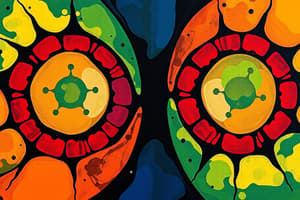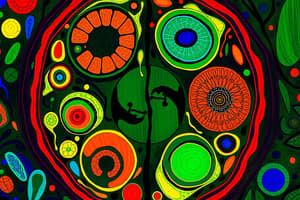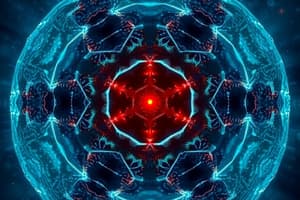Podcast
Questions and Answers
Which process is primarily responsible for increasing the number of cells in a multicellular organism during growth?
Which process is primarily responsible for increasing the number of cells in a multicellular organism during growth?
What is the primary role of mitosis in tissue maintenance?
What is the primary role of mitosis in tissue maintenance?
Which of the following best describes the relationship between mitosis and asexual reproduction?
Which of the following best describes the relationship between mitosis and asexual reproduction?
What is a significant disadvantage of asexual reproduction compared to sexual reproduction?
What is a significant disadvantage of asexual reproduction compared to sexual reproduction?
Signup and view all the answers
How does mitosis contribute to genetic stability?
How does mitosis contribute to genetic stability?
Signup and view all the answers
Which process is responsible for creating gametes required for sexual reproduction?
Which process is responsible for creating gametes required for sexual reproduction?
Signup and view all the answers
What process immediately follows fertilization in a sexually reproducing organism to produce many new cells?
What process immediately follows fertilization in a sexually reproducing organism to produce many new cells?
Signup and view all the answers
What is the primary role of histones in the structure of chromosomes?
What is the primary role of histones in the structure of chromosomes?
Signup and view all the answers
Why do chromosomes become more visible during cell division?
Why do chromosomes become more visible during cell division?
Signup and view all the answers
What is the term for the identical copies of a chromosome formed during DNA replication?
What is the term for the identical copies of a chromosome formed during DNA replication?
Signup and view all the answers
How many pairs of sex chromosomes do humans typically have?
How many pairs of sex chromosomes do humans typically have?
Signup and view all the answers
What is the term for the complete set of chromosomes photographed and arranged in pairs?
What is the term for the complete set of chromosomes photographed and arranged in pairs?
Signup and view all the answers
What is the approximate distance between two nucleosomes, in terms of DNA's nucleotide length?
What is the approximate distance between two nucleosomes, in terms of DNA's nucleotide length?
Signup and view all the answers
During which phase of the cell cycle are chromosomes uncoiled and difficult to observe under a microscope?
During which phase of the cell cycle are chromosomes uncoiled and difficult to observe under a microscope?
Signup and view all the answers
If the DNA from a single human chromosome were stretched out end-to-end, what would its approximate length be equivalent to?
If the DNA from a single human chromosome were stretched out end-to-end, what would its approximate length be equivalent to?
Signup and view all the answers
What is the role of the "seal" applied to the open end of DNA, as mentioned in the text?
What is the role of the "seal" applied to the open end of DNA, as mentioned in the text?
Signup and view all the answers
During which phase of mitosis do the centromeres split, resulting in sister chromatids becoming individual chromosomes?
During which phase of mitosis do the centromeres split, resulting in sister chromatids becoming individual chromosomes?
Signup and view all the answers
What is the primary role of spindle fibers during anaphase?
What is the primary role of spindle fibers during anaphase?
Signup and view all the answers
Which of the following is a key characteristic of telophase?
Which of the following is a key characteristic of telophase?
Signup and view all the answers
What distinguishes cytokinesis in animal cells from that of plant cells?
What distinguishes cytokinesis in animal cells from that of plant cells?
Signup and view all the answers
What is the ultimate result of mitosis and cytokinesis?
What is the ultimate result of mitosis and cytokinesis?
Signup and view all the answers
If a cell has 20 chromosomes prior to mitosis, how many chromosomes will each daughter cell have after cytokinesis?
If a cell has 20 chromosomes prior to mitosis, how many chromosomes will each daughter cell have after cytokinesis?
Signup and view all the answers
What powers the movement of chromosomes during anaphase?
What powers the movement of chromosomes during anaphase?
Signup and view all the answers
What is the result of a failure in the cell cycle control mechanism?
What is the result of a failure in the cell cycle control mechanism?
Signup and view all the answers
During which phase do chromosomes begin to uncoil and become less visible under a microscope?
During which phase do chromosomes begin to uncoil and become less visible under a microscope?
Signup and view all the answers
What process occurs after telophase to complete the division of cells?
What process occurs after telophase to complete the division of cells?
Signup and view all the answers
What is the primary role of cyclins in the cell cycle?
What is the primary role of cyclins in the cell cycle?
Signup and view all the answers
CDKs are essential because they activate the next phase of the cell cycle. What do they work in conjunction with?
CDKs are essential because they activate the next phase of the cell cycle. What do they work in conjunction with?
Signup and view all the answers
Which of the following describes the function of checkpoints within the cell cycle?
Which of the following describes the function of checkpoints within the cell cycle?
Signup and view all the answers
Permanent cells, like nerve cells, differ from other cell types primarily because they:
Permanent cells, like nerve cells, differ from other cell types primarily because they:
Signup and view all the answers
What ensures that each daughter cell has a complete set of chromosomes during cell division?
What ensures that each daughter cell has a complete set of chromosomes during cell division?
Signup and view all the answers
What is the primary function of the spindle apparatus during mitosis?
What is the primary function of the spindle apparatus during mitosis?
Signup and view all the answers
During which phase of interphase does DNA replication occur?
During which phase of interphase does DNA replication occur?
Signup and view all the answers
What is the significant outcome of the metaphase stage in mitosis?
What is the significant outcome of the metaphase stage in mitosis?
Signup and view all the answers
Which structural change happens to chromosomes during prophase?
Which structural change happens to chromosomes during prophase?
Signup and view all the answers
Which event characterizes the G₂ phase of interphase?
Which event characterizes the G₂ phase of interphase?
Signup and view all the answers
What is the role of the centrioles (in animal cells) during mitosis?
What is the role of the centrioles (in animal cells) during mitosis?
Signup and view all the answers
What happens to the nucleolus during prophase?
What happens to the nucleolus during prophase?
Signup and view all the answers
Which of the following processes occurs during the S phase?
Which of the following processes occurs during the S phase?
Signup and view all the answers
What is the purpose of the G₁ phase of interphase?
What is the purpose of the G₁ phase of interphase?
Signup and view all the answers
What is the structure of a chromosome just before the metaphase stage?
What is the structure of a chromosome just before the metaphase stage?
Signup and view all the answers
Flashcards
Mitosis
Mitosis
The process where a single cell divides into two identical daughter cells.
Growth in multicellular organisms
Growth in multicellular organisms
The growth of multicellular organisms happens by increasing the number of cells through mitosis.
Repair and replacement
Repair and replacement
Mitosis replaces damaged or worn-out cells, maintaining tissue health.
Asexual reproduction
Asexual reproduction
Signup and view all the flashcards
Sexual reproduction
Sexual reproduction
Signup and view all the flashcards
Meiosis
Meiosis
Signup and view all the flashcards
Fertilization
Fertilization
Signup and view all the flashcards
What are chromosomes?
What are chromosomes?
Signup and view all the flashcards
What is DNA and what does it do?
What is DNA and what does it do?
Signup and view all the flashcards
What are histones, and what do they do?
What are histones, and what do they do?
Signup and view all the flashcards
What is a nucleosome?
What is a nucleosome?
Signup and view all the flashcards
What is a karyotype?
What is a karyotype?
Signup and view all the flashcards
When are chromosomes visible?
When are chromosomes visible?
Signup and view all the flashcards
How many chromosomes do humans have?
How many chromosomes do humans have?
Signup and view all the flashcards
What are sister chromatids?
What are sister chromatids?
Signup and view all the flashcards
What happens to sister chromatids during cell division?
What happens to sister chromatids during cell division?
Signup and view all the flashcards
What are cyclins?
What are cyclins?
Signup and view all the flashcards
What are CDKs?
What are CDKs?
Signup and view all the flashcards
What are checkpoints in the cell cycle?
What are checkpoints in the cell cycle?
Signup and view all the flashcards
What is asexual reproduction?
What is asexual reproduction?
Signup and view all the flashcards
What are permanent cells?
What are permanent cells?
Signup and view all the flashcards
What happens during Anaphase?
What happens during Anaphase?
Signup and view all the flashcards
What happens during Telophase?
What happens during Telophase?
Signup and view all the flashcards
How does cytokinesis happen in animal cells?
How does cytokinesis happen in animal cells?
Signup and view all the flashcards
How does cytokinesis happen in plant cells?
How does cytokinesis happen in plant cells?
Signup and view all the flashcards
What is the purpose of the cell cycle regulation?
What is the purpose of the cell cycle regulation?
Signup and view all the flashcards
What happens if errors are detected in the cell cycle?
What happens if errors are detected in the cell cycle?
Signup and view all the flashcards
Why is cell cycle regulation important for cancer prevention?
Why is cell cycle regulation important for cancer prevention?
Signup and view all the flashcards
What triggers cell cycle checkpoints?
What triggers cell cycle checkpoints?
Signup and view all the flashcards
G1 Phase: Cell Growth
G1 Phase: Cell Growth
Signup and view all the flashcards
S Phase: DNA Replication
S Phase: DNA Replication
Signup and view all the flashcards
G2 Phase: Getting Ready
G2 Phase: Getting Ready
Signup and view all the flashcards
Mitosis: Nuclear Division
Mitosis: Nuclear Division
Signup and view all the flashcards
Prophase: Preparing for Separation
Prophase: Preparing for Separation
Signup and view all the flashcards
Metaphase: Alignment and Attachment
Metaphase: Alignment and Attachment
Signup and view all the flashcards
Anaphase: Pulling Apart
Anaphase: Pulling Apart
Signup and view all the flashcards
Telophase: Final Steps
Telophase: Final Steps
Signup and view all the flashcards
Cytokinesis: Division of the Cytoplasm
Cytokinesis: Division of the Cytoplasm
Signup and view all the flashcards
The Importance of Cell Division
The Importance of Cell Division
Signup and view all the flashcards
Study Notes
Cell Cycle
- The cell cycle is a repeating process where cells grow, divide, and form new cells.
- This cycle has specific steps to ensure proper division.
Cell Division and Reproduction
- Mitosis (Main Type of Cell Division): A process where a single cell divides into two cells with identical DNA.
- Purpose:
- Growth: Multicellular organisms grow by increasing the number of cells through mitosis.
- Repair and Replacement: Repair of worn-out or damaged cells, maintaining tissue health (e.g., skin and blood cells).
- Asexual Reproduction: Some organisms reproduce asexually through mitosis, producing clones. (e.g., bacteria, some plants)
- Genetic Stability: Ensures the daughter cells have the same number and type of chromosomes as the parent cell.
Advantages of Asexual Reproduction
- No need for a mate.
- Rapid reproduction allows quick population growth.
Disadvantages of Asexual Reproduction
- Lack of genetic diversity, making populations vulnerable to environmental changes.
Sexual Reproduction (Meiosis)
- Depends on meiosis to create gametes (sex cells).
- After fertilization (fusion of gametes), mitosis takes over to produce new cells for the developing organism.
Chromosomes
-
Chromosomes are like "instruction manuals" inside each cell.
-
They carry all the genetic information (DNA).
-
Structure and Importance:
- Made of DNA wrapped tightly around proteins called histones.
- Histones act like spools for DNA.
- Organize and condense DNA into neat bundles called nucleosomes.
- Each nucleosome contains two turns of DNA wrapped around a set of eight histone proteins. The distance between 2 nucleosomes is almost 20 nucleotides.
- This packaging is essential because DNA is extremely long; if stretched out, the DNA in one chromosome would be as long as a football field.
Visibility of Chromosomes
- Inactive Cell: When a cell is not dividing, chromosomes are thin, uncoiled, hard to see.
- Dividing cell: Chromosomes coil tightly, become denser, easy to see under a microscope.
How Chromosomes Work During Mitosis
- Before division: Each chromosome is copied to create two identical copies (sister chromatids).
- During Division: The chromatids are split and shared equally between two new cells, ensuring each daughter cell has the same DNA.
Human Chromosome Count
- Humans have 46 chromosomes (23 pairs).
- One chromosome of each pair comes from the mother, the other from the father.
Karyotype
- A visual representation of all chromosomes in a cell, organized in pairs.
- Helpful in diagnosing genetic disorders. Example: Humans have 22 pairs of autosomes (non-sex chromosomes) and 1 pair of sex chromosomes (XX for females, XY for males).
Interphase (Preparation Phase)
- It is the stage before mitosis, often referred to as the cell's resting stage.
- However, it is highly active internally.
- Key processes: DNA replication, organelle production, ATP production.
- Interphase has three stages: G1, S, and G2.
- G1 phase: The cell grows and collects materials needed for the next steps.
- S phase: DNA replication occurs; single chromosomes become double-stranded.
- G2 phase: Organelles and other materials are formed.
Mitosis (Division of the Nucleus or karyokinesis)
- Mitosis is divided into four distinct stages: Prophase, Metaphase, Anaphase, and Telophase. A helpful mnemonic is PMAT.
- Prophase: Chromosomes condense, becoming visible; nuclear envelope breaks down; centrioles move to opposite poles in animal cells.
- Metaphase: Chromosomes align along the center of the cell (metaphase plate); spindle fibers attach to centromeres.
- Anaphase: Centromeres split; sister chromatids separate and move to opposite poles; spindle fibers pull the chromosomes.
- Telophase: Two complete sets of chromosomes reach the poles and start to uncoil; nuclear envelope reforms around each set of chromosomes; spindle fibers disassemble; two distinct nuclei become visible.
Cytokinesis (Division of the Cytoplasm)
- Cell's cytoplasm divides, forming two separate cells.
- Animal cells: A ring of contractile fibers forms around the cell's center, pinching the cell in two.
- Plant cells: A cell plate forms at the center, developing into a new cell wall separating the two daughter cells.
Mitotic Index
- The mitotic index measures how actively cells in a tissue are dividing.
- Calculated as the ratio of cells in mitosis to the total number of cells in a sample. Useful for monitoring cancer or other tissue health.
Cell Cycle Control
- Tightly regulated to ensure cell division takes place only when needed.
- Cyclins and CDKs (Cyclin-Dependent Kinases) control the timing.
Key Takeaways on Mitosis
- Mitosis ensures that all new cells have the same DNA as the original. Mitosis is necessary for growth, cell repair and some forms of reproduction.
- Chromosomes must be duplicated before dividing; each daughter cell receives a complete set during the process.
- The cell cycle is precisely controlled using proteins like cyclins and CDKs.
- Cells divide at different rates (some fast, some slow). This affects the rate of the cell cycle in different types of cells.
Studying That Suits You
Use AI to generate personalized quizzes and flashcards to suit your learning preferences.
Related Documents
Description
Explore the intricate processes of the cell cycle, focusing on mitosis and its importance in growth, repair, and asexual reproduction. Understand the advantages and disadvantages of asexual reproduction as well as its role in maintaining genetic stability. This quiz will test your knowledge on how cells divide and the significance of these processes.




